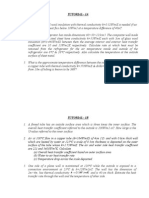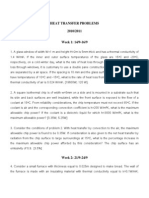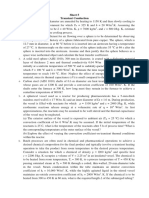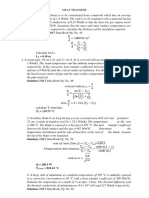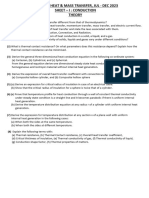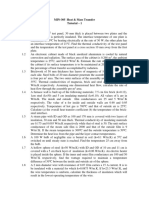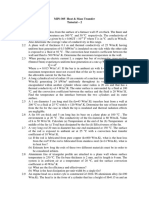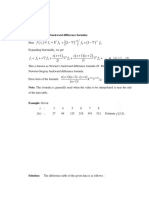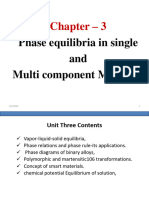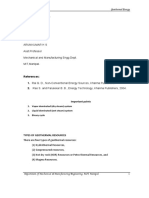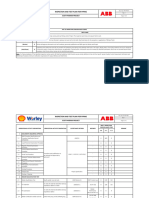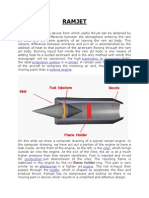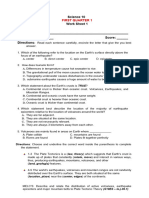MIN-305 Heat & Mass Transfer
Tutorial – 3
3.1 A two-dimensional rectangular plane is subjected to prescribed boundary conditions.
Using the results of the exact solution for the heat equation, calculate the temperaturte
at the mid point (1,0.5) by considering the first five nonzero terms of the infinite series
that must be evaluated.
3.2 The temperatures (K) at the nodal points of a two-dimensional system are as shown.
Surface B is held at a uniform temperature, while surface A is subjected to a
convection boundary condition. Calculate the heat rate leaving surface A per unit
thickness normal to the page. Estimate the thermal conductivity of the material.
3.3 Consider two-dimensional, steady-state conduction in a square cross section with
prescribed surface temperatures. Determine the temperatures at nodes 1,2, 3, and 4.
Estimate the midpoint temperature.
3.4 The steady-state temperatures (C) associated with selected nodal ponts of a two-
dimensional system having a thermal conductivity of 1.5 W/m.K are shown on the
accompanying grid.
� (a) Determine the temperatures at nodes 1,2, and 3.
(b) Calculate the heat transfer rate per unit thickness normal to the page from the
system to the fluid.
3.5 A steel ball (c=0.46 kJ/kg.K, k=35 W/m.K, =7800 kg/m3), 5 cm in diameter, and
initially at a uniform temperature of 450 C is suddenly placed in a controlled
environment in which the temperature is maintained at 100 C. The convection heat
transfer coefficient is 10 W/m2.K. Calculate the time required for the ball to attain a
temperature of 150 C.
3.6 The heat transfer coefficient of a 22 gauge chromel-alumel thermocouple in a gas
stream is 570 W/m2.K. what is the time constant in seconds (cp=0.42 kJ/kg.K, =8600
kg/m3).
3.7 Steel is sequentially heated and cooled (annealed) to relieve stresses and to make it less
brittle. Consider a 100-mm-thick plate (k=45W/m.K, =7800 kg/m3, cp=500 J/kg.K(
that is initially at a uniform temperature of 300 C and is heated (on both sides) in a gas
fired furnace for which To =700 C and h=500 W/m2.K. How long willit take for a
minimum temperature of 550 C to be reached in the plate.
3.8 A long cylinder of 30 mm diameter, initially at a uniform temperature of 1000 K, is
suddenly quenched in a large, constant-temperature oil bath at 350 K. The cylinder
properties are k=1.7 W/m.K, c=1600 j/kg.K, and =400 kg/m3, while the convection
coefficient is 50 W/m2.K.
(a) Calculate the time required for the surface of the cylinder to reach 500 K.
3.9 A new process for treatment of special material is to be evaluated. The material, a
sphere of radius ro=5 mm, is initially in equilibrium at 400 C in a furnace. It is
suddenly removed from the furnace and subjected to a two-step cooling process.
Step 1 Cooling in air at 20 C for a period of time a until the center temperature
reaches a critical value, Ta(0,a)=335 C. For this situation, the convective heat transfer
coefficient is ha=10 W/m2.K.
After the sphere has reached this critical temperature, the second step is initiated.
Step 2 Cooling in a well-stirred water bath at 20 C, with a convective heat transfer
coefficient of hw=6000 W/m2.K.
The thermophysical properties of the material are =3000 kg/m3, k=20 W/m.K,
c=1000 J/kg.K and =6.66x10-6 m2/s.
1. Calculate the time a required for step 1 of the cooling process to be completed.
2. Calculate the time w required during step 2 of the process for the center of the
sphere to cool from 335 C (the condition at the completion of step 1) to 50 C.
3.10 Determine the temperature in a plane 18 cm from the surface of a thick wall and also
the rate of heat flow into 1 m2 of this plane 10 hours after the surface temperature of the
wall changes suddenly from 20 C to 820 C and remains constant thereafter. Also find
the total heat energy taken up by the wall in 10 hrs. Given k=0.87 W/m.K and
=2.78x10-3 m2/hr.
3.11 A moulded plastic product (=1200 kg/m3, c=1500 J/kg.K, k=0.30 W/m.K) is cooled
by exposing one surface to an array of air jets, while the opposite surface is well
�insulated. The product may be approximated as a slab of thickness L=60 mm, which is
initially at a uniform temperature of Ti= 80 C. The air jets are at a temperature of
To =20 C and provide a uniform convection coefficient of h=100 W/m2.K at the cooled
surface. Using a finite-difference solution with a space increment of x=6 mm,
determine temperatures at the cooled and insulated surfaces after 1 hour of exposure to
the gas jets.










